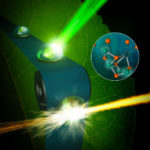An article published in the Computing Sciences News Center describes how Biosciences researchers are using a superfacility framework of experimental instrumentation with computational and data facilities to unravel the long-standing mystery of how Photosystem (PSII) works. The protein complex plays a crucial role in photosynthesis, making it key to achieving artificial photosynthesis that could produce fuels using sunlight and carbon dioxide. Researchers—led by Vittal Yachandra, Junko Yano, and Jan Kern in Molecular Biophysics and Integrated Bioimaging (MBIB)—recently began using ESnet to enable real-time processing of experimental data collected at the SLAC National Accelerator Laboratory’s Linac Coherent Light Source (LCLS) at NERSC to observe this water-splitting protein in action. Asmit Bhowmick, a postdoctoral researcher in the laboratory of MBIB senior scientist Nicholas Sauter, is quoted in the article.
Scientists Capture Photosynthesis in Unprecedented Detail
Using the SLAC National Accelerator Laboratory’s Linac Coherent Light Source (LCLS) X-ray laser, an international collaboration led by scientists at Berkeley Lab and SLAC captured the all four stable oxidation states of photosystem II— plus two transitional states—at natural temperature and the highest resolution to date.
X-rays Capture Unprecedented Images of Photosynthesis in Action
An international team of scientists is getting closer to discovering how plants split water during photosynthesis and produce nearly all of the oxygen in our atmosphere. Thanks to unprecedented, atomic-scale images of a protein complex found in plants, algae, and cyanobacteria captured by ultrafast X-ray lasers, researchers conducted atomic-level experiments to help delineate the mechanism of this system that also yields the protons and electrons used to reduce carbon dioxide to carbohydrates later in the photosynthesis cycle. The effort to uncover the secrets of this protein complex, photosystem II, was led by Vittal Yachandra and Junko Yano in the Molecular Biophysics & Integrated Bioimaging (MBIB) Division and the team’s findings were published this week in Nature.
Was this page useful?






